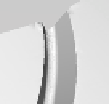Information Technology Reference
In-Depth Information
area of the cutting edge corresponds with a changing chip formation and a varying
load during the cutting. This varying load has negative influence on the tool wear
behavior. Hence, the gradient should have a minimum value.
Besides the aspect of chip compression and the so caused tool load further charac-
teristic values for analyzing the cutting process can be used. The entire working
length l
e
describes the contact length, which the cutter is in contact with the workpiece
under consideration of the working direction, see figure 9. So the working length is a
geometrical approach for the description of the thermal and mechanical load on the
cutting edge. A higher working length results in a higher temperature respectively
friction and thus in higher loads on the cutting edge.
Additionally, the working relief angle α
e
can be used for the analysis of the tool
load. The working relief angle influences the thermal stress on the cutting edge. Thus
the gradient Δα
e
/Δl
s
is a useful characteristic value for the alternating thermal stress
along the cutting edge. The higher the gradient is the higher will be the alternating
thermal stresses on the relief face of the cutter. Hence, a minimum value of the gra-
dient is desirable. In order to integrate the presented characteristic values in only one
value K
G
is introduced:
Δ
h
Δα
Δγ
cu
e
e
K
=
l
⋅
⋅
⋅
(3)
G
e
Δ
l
Δ
l
Δ
l
s
s
s
Characteristic Values for Mechanical and Thermal Load
Gradient Working Relief Angle
Δα
e
/
Δ
l
s
Working Length l
e
tool
+
α
e
chip
b
l
-
α
e
workpiece
l
s
Δ
Δ
Δ
α
e
l
Δα
e
l
s
OB
T
IB
T
cutting edge length l
s
OB
OB
cuttin edge length l
s
Fig. 9.
Description of mechanical and thermal load by geometrical characteristic values
A high K
G
value results in a higher tool load and thus in higher tool wear. With the
new characteristic value K
G
a first qualitative comparison of different processes and
so of the tool wear is possible. From this an optimization of the process is feasible and
a first approach for a qualitative tool wear prediction model is realized.
In the future the characteristic value with the tool wear model has to be modified
by weighting of the coefficients in order to enable a quantitative evaluation and pre-
diction of the tool wear.
































Search WWH ::

Custom Search